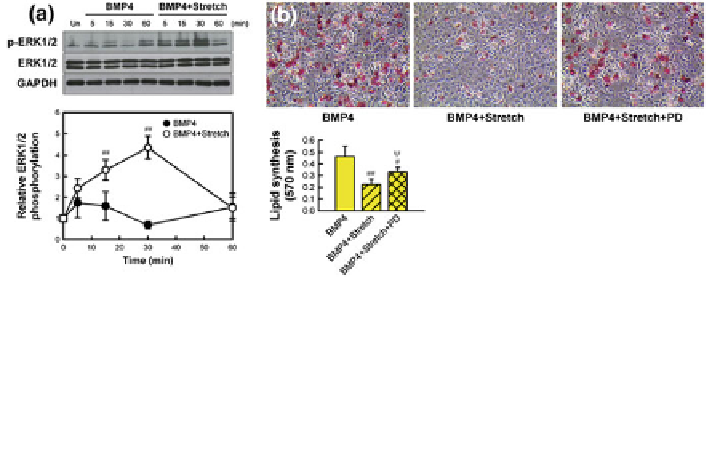Biomedical Engineering Reference
In-Depth Information
Fig. 3 Cyclic stretch suppression of BMP4-induced MSC adipogenesis may be achieved through
stretch-induced ERK activation. a Cyclic stretch (10 %, 0.25 Hz) induced ERK1/2 phosphor-
ylation. BMP4 treatment alone did not induce ERK activation. ERK phosphorylation (p-) was
assessed by immunoblotting and normalized to total ERK. Comparison at the same time point:
##: p \ 0.01. b Cyclic cell stretch under ERK inhibitor, PD98059 (PD), resulted in less
significant reduction in lipid accumulation. Oil red O staining images and quantified data.
Comparison with BMP4 (#, ##) and BMP4 plus stretch (w): p \ 0.05 (#, w), p \ 0.01 (##).
Reprinted with permission from Elsevier [
24
]
observed that MSCs exposed to cyclic stretch of 2 % strain at 3600 cycles a day
inactivated GSK3b and that mechanical inhibition of GSK3b induces the activation
of both b-catenin and NFATc1 signaling, limiting the adipogenesis of MSCs.
While the role of b-catenin in inhibiting MSC adipogenesis under cyclic cell
stretch is now partly known, more knowledge needs to be revealed to fully
understand the mechanical stretch control of MSC fate. For example, b-catenin is a
linker protein for cadherin cell-cell interaction protein to be connected to the
cytoskeleton. For b-catenin to be translocated into nucleus under stretch stimu-
lation, b-catenin is to be disassembled from the cadherin-b-catenin complex.
However, there is very little or no knowledge in regard to the role of cadherin cell-
cell interaction molecule in regulating the mechanical control of MSCs. As cell-
cell interaction also plays a vital role in cell differentiation even in static cell
culture conditions [
32
], assessing signaling mechanisms incorporating cadherin
and b-catenin may reveal a new perspective on MSC fate control by cell stretch.
The other molecular mechanism of stretch control of adipogenesis may include
focal adhesion-cytoskeleton signaling. A recent study researched the effects of
mechanical strain on mTORC2, which is a protein complex that regulates the
cytoskeleton [
42
]. The cytoskeleton responds to physical cues from the environ-
ment via remodeling or reorganization. They observed that biaxial cyclic stretch
(100 cycles of 2 % strain at 10 cycles/min) caused a restructuring of the cyto-
skeleton and also affected stem cell signaling, both of which were mediated by
mTORC2. Importantly, by activating mTORC2 with stretch, MSC osteogenesis
was stimulated by creating a stiffer cytoskeleton and its adipogenesis was pre-
vented. Again, the increased osteogenesis over adipogenesis was mediated by

Search WWH ::

Custom Search